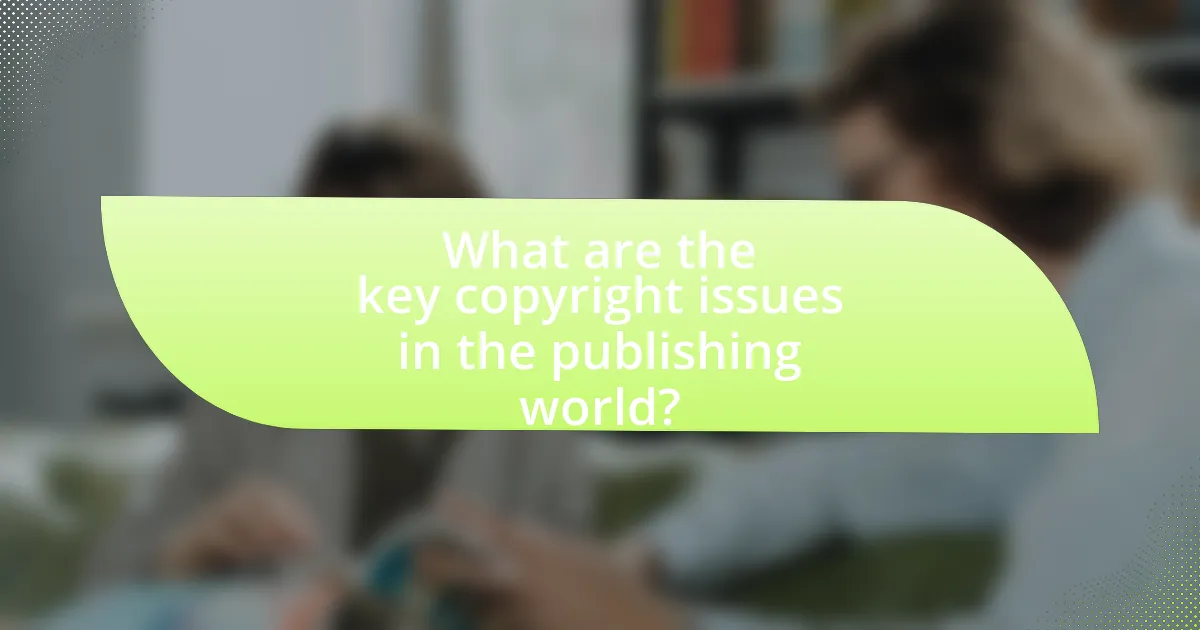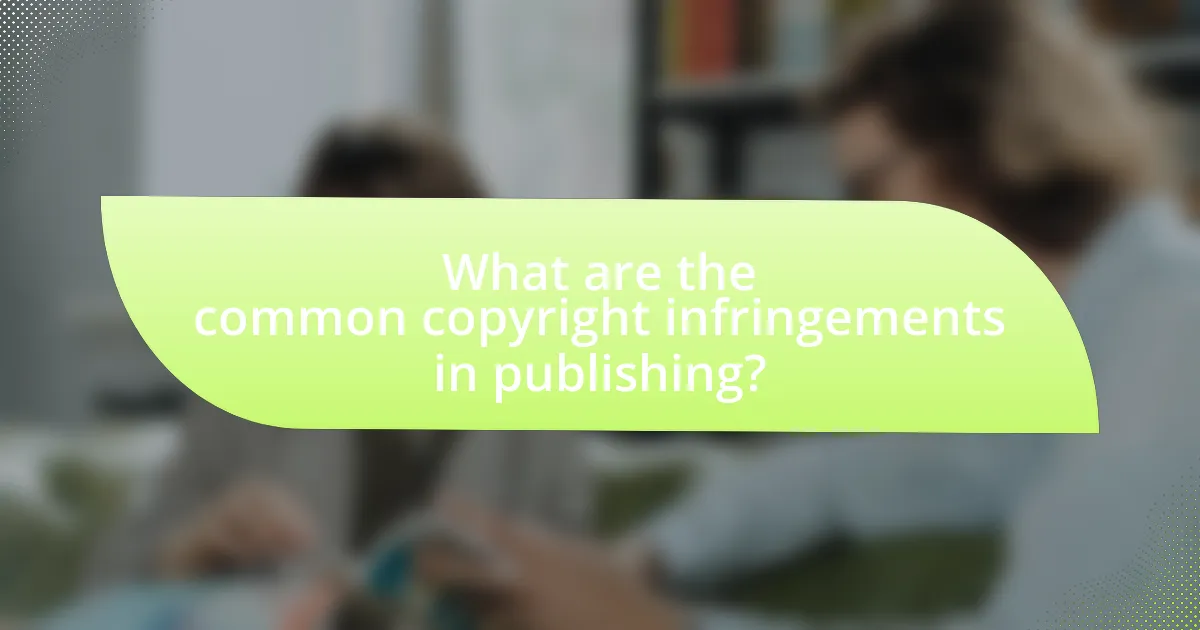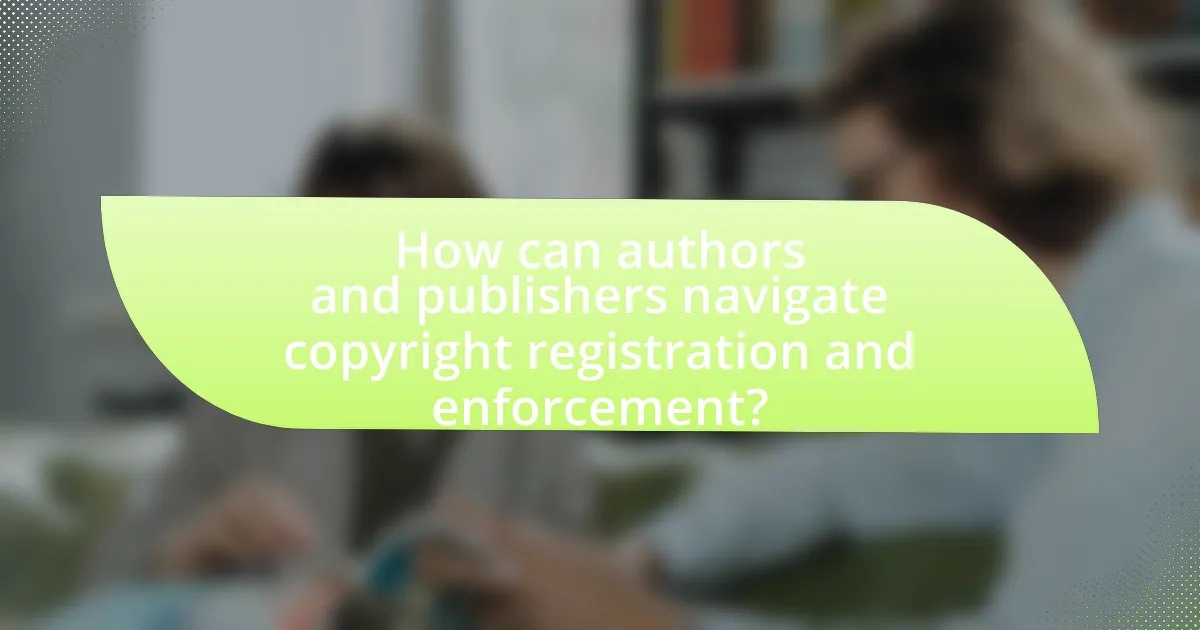The article focuses on navigating copyright issues in the publishing world, addressing key topics such as copyright infringement, fair use, licensing agreements, and digital rights management. It outlines how copyright law applies to various types of published works, including literary, visual, and musical creations, while highlighting the distinctions in copyright protection for books, articles, and digital content. The article also examines the variations in copyright laws across different countries, the importance of understanding these laws for authors and publishers, and the risks associated with ignoring copyright issues. Additionally, it provides practical tips for obtaining permissions, ensuring compliance, and enforcing copyright rights, along with resources for staying informed about changes in copyright legislation.

What are the key copyright issues in the publishing world?
Key copyright issues in the publishing world include copyright infringement, fair use, licensing agreements, and digital rights management. Copyright infringement occurs when a work is reproduced or distributed without permission from the copyright holder, which can lead to legal disputes and financial penalties. Fair use allows limited use of copyrighted material without permission for purposes such as criticism, comment, news reporting, teaching, scholarship, or research, but its application can be subjective and varies by jurisdiction. Licensing agreements are essential for defining the terms under which copyrighted works can be used, and they often involve negotiations between authors, publishers, and distributors. Digital rights management (DRM) technologies are employed to protect digital content from unauthorized use, but they can also restrict legitimate access and use by consumers. These issues are critical as they shape the legal landscape of publishing and impact the rights of authors and publishers alike.
How does copyright law apply to different types of published works?
Copyright law grants creators exclusive rights to their published works, which vary based on the type of work. For literary works, copyright protects the expression of ideas in written form, allowing authors to control reproduction and distribution. In the case of visual art, copyright safeguards the artist’s original creations, preventing unauthorized use or reproduction. Musical works receive similar protection, covering both the composition and the recording, ensuring that musicians can control how their music is used. Additionally, copyright law applies to audiovisual works, such as films and videos, granting rights to the creators over the distribution and performance of their content. These protections are established under the Copyright Act of 1976 in the United States, which outlines the rights of authors and the duration of copyright, typically lasting the life of the author plus 70 years.
What are the distinctions between copyright for books, articles, and digital content?
Copyright for books, articles, and digital content differs primarily in terms of duration, scope, and enforcement mechanisms. Books typically enjoy copyright protection for the life of the author plus 70 years, while articles may have similar protection but can vary based on publication agreements. Digital content, including websites and online articles, often faces shorter copyright terms due to the rapid pace of technological change and may be subject to different licensing agreements, such as Creative Commons. Additionally, enforcement of copyright can be more complex for digital content due to ease of reproduction and distribution online, leading to increased instances of infringement. These distinctions are crucial for authors and publishers to understand in order to navigate copyright issues effectively.
How do copyright laws vary across different countries?
Copyright laws vary significantly across different countries due to differences in legal frameworks, cultural values, and international treaties. For instance, the United States operates under the Copyright Act of 1976, which grants authors exclusive rights for the life of the author plus 70 years, while the European Union follows the EU Copyright Directive, which also provides similar protections but includes specific provisions for digital content and exceptions for educational use. Additionally, countries like India have their own Copyright Act, which allows for compulsory licensing under certain conditions, reflecting local economic and cultural considerations. These variations are further influenced by international agreements such as the Berne Convention, which establishes minimum standards for copyright protection but allows member countries to implement their own laws.
Why is understanding copyright important for authors and publishers?
Understanding copyright is crucial for authors and publishers because it protects their intellectual property rights and ensures they receive proper recognition and compensation for their work. Copyright law grants authors exclusive rights to reproduce, distribute, and display their creations, which is essential for maintaining control over their content and preventing unauthorized use. For instance, according to the U.S. Copyright Office, copyright protection automatically applies to original works of authorship fixed in a tangible medium, which underscores the importance of understanding these rights to safeguard creative efforts and financial interests in the publishing industry.
What risks do authors face if they ignore copyright issues?
Authors face significant legal and financial risks if they ignore copyright issues, including potential lawsuits and substantial monetary damages. When authors fail to respect copyright laws, they may be subject to infringement claims, which can lead to costly legal battles and the possibility of having to pay damages that can reach up to $150,000 per work in statutory damages, as established by the U.S. Copyright Act. Additionally, authors may lose their rights to their own work, as publishers or other entities may claim ownership if copyright is not properly asserted. Ignoring copyright can also damage an author’s reputation and credibility within the industry, leading to loss of future publishing opportunities.
How can publishers protect their intellectual property rights?
Publishers can protect their intellectual property rights by registering their works with copyright offices and utilizing licensing agreements. Copyright registration provides legal recognition and the ability to enforce rights against infringement, as established by the U.S. Copyright Office, which notes that registration is a prerequisite for filing a lawsuit for infringement. Additionally, licensing agreements allow publishers to define the terms under which their works can be used, ensuring that they retain control over their intellectual property and can seek compensation for its use.

What are the common copyright infringements in publishing?
Common copyright infringements in publishing include unauthorized reproduction, distribution, and adaptation of copyrighted works. Unauthorized reproduction occurs when a publisher prints or copies a work without permission from the copyright holder. Distribution infringement happens when copies of a work are shared or sold without authorization. Adaptation infringement involves creating derivative works, such as translations or adaptations, without consent. These actions violate the rights granted to copyright holders under laws like the Copyright Act of 1976 in the United States, which protects original works of authorship.
How can unauthorized use of content lead to legal disputes?
Unauthorized use of content can lead to legal disputes primarily through copyright infringement claims. When an individual or entity uses copyrighted material without permission from the rights holder, it violates the exclusive rights granted to the copyright owner, which can result in lawsuits seeking damages or injunctions. According to the U.S. Copyright Office, unauthorized reproduction, distribution, or display of copyrighted works constitutes infringement, and the copyright owner has the right to enforce their rights through legal action. This legal framework is designed to protect creators and their intellectual property, ensuring that unauthorized use can lead to significant financial and reputational consequences for the infringer.
What are the most frequent examples of copyright infringement in publishing?
The most frequent examples of copyright infringement in publishing include unauthorized reproduction of texts, plagiarism, and the use of copyrighted images without permission. Unauthorized reproduction occurs when a publisher prints or distributes a work without the author’s consent, violating the exclusive rights granted by copyright law. Plagiarism involves presenting someone else’s work or ideas as one’s own, which can lead to legal repercussions and damage to reputation. The use of copyrighted images without proper licensing or attribution is also a common infringement, as it disregards the rights of the original creator. These actions can result in lawsuits, financial penalties, and loss of credibility in the publishing industry.
How do fair use and public domain affect copyright infringement cases?
Fair use and public domain significantly influence copyright infringement cases by providing legal defenses against claims of infringement. Fair use allows limited use of copyrighted material without permission for purposes such as criticism, comment, news reporting, teaching, scholarship, or research, as established in the U.S. Copyright Act. Courts evaluate fair use based on four factors: the purpose of use, the nature of the copyrighted work, the amount used, and the effect on the market value of the original work. Public domain refers to works that are no longer protected by copyright, allowing anyone to use them freely. Works enter the public domain after the copyright term expires or if the creator explicitly places them there. Therefore, if a work is in the public domain, it cannot be subject to copyright infringement claims. These concepts provide essential frameworks for determining whether a use constitutes infringement or is legally permissible.
What steps can be taken to avoid copyright infringement?
To avoid copyright infringement, individuals and organizations should obtain permission for the use of copyrighted material. This involves identifying the copyright holder and requesting a license or written consent to use their work. Additionally, creators can utilize public domain works or materials licensed under Creative Commons, which often allow for reuse under specific conditions. Implementing proper attribution practices when using others’ work is also essential, as it acknowledges the original creator and may help mitigate infringement claims. Furthermore, understanding the concept of fair use can guide users in determining whether their use of copyrighted material falls within permissible limits, although this can be complex and context-dependent.
What are best practices for obtaining permissions for using copyrighted material?
The best practices for obtaining permissions for using copyrighted material include identifying the copyright holder, clearly stating the intended use, and documenting the permission request process. Identifying the copyright holder ensures that the correct entity is approached for permission, which is crucial since copyright law protects the rights of creators. Clearly stating the intended use, such as whether the material will be used for commercial or educational purposes, helps the copyright holder make an informed decision. Documenting the permission request process, including keeping records of communications and agreements, provides legal protection and clarity in case of disputes. These practices align with copyright law requirements and help mitigate the risk of infringement.
How can authors and publishers ensure compliance with copyright laws?
Authors and publishers can ensure compliance with copyright laws by obtaining proper licenses for any copyrighted material they wish to use and by understanding the scope of fair use. Proper licensing involves securing permissions from copyright holders for the reproduction or distribution of their works, which is essential to avoid infringement. Fair use allows limited use of copyrighted material without permission under specific circumstances, such as criticism, comment, news reporting, teaching, scholarship, or research, but the application of fair use can be complex and context-dependent. Therefore, authors and publishers should also consult legal experts or copyright specialists to navigate these laws effectively and stay updated on any changes in copyright legislation.

How can authors and publishers navigate copyright registration and enforcement?
Authors and publishers can navigate copyright registration and enforcement by understanding the registration process and actively monitoring their works for infringement. The U.S. Copyright Office provides a straightforward online registration system that allows creators to register their works, which establishes a public record and is essential for enforcing rights in court. Additionally, authors and publishers should utilize tools like digital watermarking and monitoring services to detect unauthorized use of their content. According to the U.S. Copyright Office, registered works are eligible for statutory damages and attorney’s fees in case of infringement, reinforcing the importance of registration for effective enforcement.
What is the process for registering a copyright in published works?
The process for registering a copyright in published works involves submitting an application to the U.S. Copyright Office. This application requires the completion of a form, payment of a fee, and submission of a copy of the work being registered. The U.S. Copyright Office provides specific forms for different types of works, such as literary, musical, or visual works, and the registration can be completed online or via mail. According to the U.S. Copyright Office, registration is not mandatory but provides legal advantages, including the ability to sue for infringement and eligibility for statutory damages.
What documentation is required for copyright registration?
To register a copyright, the required documentation includes a completed application form, a non-refundable filing fee, and a copy of the work being registered. The application form must detail the title of the work, the author’s name, and the date of creation. The U.S. Copyright Office specifies that the work submitted can be in various formats, such as a physical copy or a digital file, depending on the type of work. This documentation is essential for establishing legal protection for the work under copyright law.
How long does the copyright registration process typically take?
The copyright registration process typically takes about three to six months. This timeframe can vary based on the volume of applications received by the U.S. Copyright Office and the complexity of the work being registered. According to the U.S. Copyright Office, the processing time can be longer during peak periods or if additional information is required from the applicant.
What are the options for enforcing copyright rights?
The options for enforcing copyright rights include sending cease-and-desist letters, filing Digital Millennium Copyright Act (DMCA) takedown notices, pursuing litigation, and seeking alternative dispute resolution methods. Cease-and-desist letters serve as formal requests to infringers to stop unauthorized use, while DMCA takedown notices allow copyright holders to request the removal of infringing content from online platforms. Litigation can lead to court orders and monetary damages, providing a legal avenue for enforcement. Alternative dispute resolution, such as mediation or arbitration, offers a less formal approach to resolving copyright disputes. These methods are supported by legal frameworks established in copyright law, which aim to protect the rights of creators and ensure compliance.
How can authors and publishers take legal action against copyright infringement?
Authors and publishers can take legal action against copyright infringement by filing a lawsuit in a federal court. This legal process typically begins with the author or publisher gathering evidence of the infringement, such as copies of the infringing work and documentation proving ownership of the original work. Once sufficient evidence is collected, they can file a complaint outlining the infringement and seeking remedies, which may include monetary damages and injunctive relief to stop further infringement. According to the U.S. Copyright Office, registering the work with the Copyright Office before filing a lawsuit strengthens the case and allows for statutory damages and attorney’s fees, enhancing the potential for a successful outcome.
What role do copyright organizations play in enforcement?
Copyright organizations play a crucial role in enforcing intellectual property rights by monitoring the use of copyrighted materials and taking action against unauthorized use. These organizations, such as the American Society of Composers, Authors and Publishers (ASCAP) and the Copyright Clearance Center (CCC), actively track the distribution and reproduction of creative works. They provide licensing services, ensuring that creators receive compensation for the use of their works, and they pursue legal action against infringers to uphold copyright laws. For instance, ASCAP reported collecting over $1.5 billion in licensing fees in 2020, demonstrating their effectiveness in enforcing copyright and protecting the interests of creators.
What practical tips can help navigate copyright issues in publishing?
To navigate copyright issues in publishing, it is essential to understand the basics of copyright law, including what constitutes original work and the duration of copyright protection. Familiarizing oneself with the Fair Use doctrine is crucial, as it outlines permissible uses of copyrighted material without permission, such as criticism, comment, news reporting, teaching, scholarship, or research. Additionally, obtaining proper licenses for any third-party content used in publications is vital to avoid infringement. Keeping detailed records of permissions and licenses can help in case of disputes. Furthermore, consulting with a copyright attorney can provide tailored advice and ensure compliance with copyright laws. These strategies are supported by the U.S. Copyright Office, which emphasizes the importance of understanding copyright to protect both creators and users of content.
How can authors and publishers stay informed about copyright changes and updates?
Authors and publishers can stay informed about copyright changes and updates by subscribing to legal newsletters, following copyright organizations, and attending industry conferences. Legal newsletters, such as those from the American Bar Association, provide timely updates on copyright law changes. Organizations like the Copyright Office and the Authors Guild offer resources and alerts on relevant legislative developments. Additionally, industry conferences often feature sessions on copyright issues, allowing professionals to engage with experts and network with peers. These methods ensure that authors and publishers remain knowledgeable about evolving copyright laws and practices.
What resources are available for understanding copyright in the publishing industry?
Resources available for understanding copyright in the publishing industry include the U.S. Copyright Office, which provides comprehensive guides and legal information on copyright laws, and the Association of American Publishers, which offers resources and advocacy for publishers regarding copyright issues. Additionally, the Copyright Clearance Center provides tools for licensing and permissions, while various online courses and webinars from organizations like the American Library Association educate individuals on copyright principles. These resources are essential for navigating the complexities of copyright in publishing, as they offer authoritative information and practical guidance.
